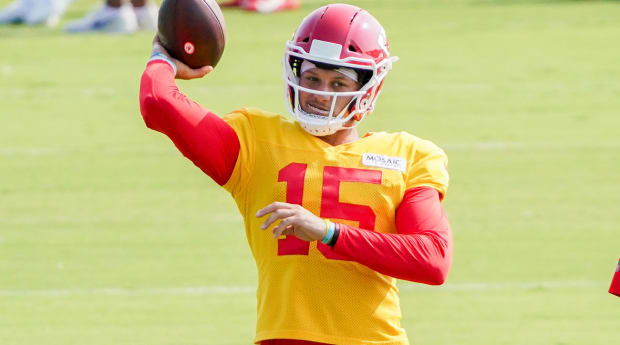Throughout the football offseason, there are certain themes we learn to ignore because they’ve lost all meaning. A player being in the best shape of his life, for example. Or another player being excited by a new scheme (which he will end up complaining about at the end of the season).
There was one trope in particular that was especially irksome: the idea of players’ getting together to play catch in the offseason. I remember being a Jets beat writer and pining for information about a Mark Sanchez pass to Braylon Edwards somewhere on a distant high school football field in Mission Viejo, Calif., as if it were going to have any tangible impact on the lives of the Jets’ players, coaches or fans moving forward.
Until, one time, it did.

Denny Medley/USA TODAY Sports
In February, while I was reporting Sports Illustrated’s Super Bowl game story with colleague Greg Bishop, he wrote this tidbit, which, in a piece thousands of words long, may have gotten overlooked. Read it again.
First, [Patrick Mahomes] dialed [head coach Andy Reid], then offensive coordinator Eric Bieniemy. He asked both the same question: Would they mind if he remained in Texas, at his home training base, but invited all of his offensive teammates? He threw in a twist. He didn’t want to hold informal workouts, like many quarterbacks. He wanted to lead Phase 1 of Kansas City’s offseason program, wanted to bond and teach. Both coaches embraced the idea because of what it signified—growth, wherewithal, ownership.
Mahomes had never before adjusted to more than two new receivers. Three free-agent signees—JuJu Smith-Schuster, Marquez Valdes-Scantling and Justin Watson—came to Fort Worth. With input from the coaches and an assist from his private quarterbacks coach, Jeff Christensen, Mahomes devised a schedule with [Travis] Kelce. The group would meet every morning. They would practice routes for between 75 and 90 minutes, searching for timing and rhythm. They would hold virtual meetings with the coaches after that to install the next day’s plays; break down film, sharing insights and preferences; and stay late for anyone needing extra work.
Colleague Albert Breer also had details about it in August.
Watch the NFL with fuboTV. Start your free trial today.
There is a marked difference between playing catch, bonding and planning paintball excursions, vs. legitimately getting the chance to install an offense on a completely “voluntary” basis, away from the team’s facility but with the support of the coaching staff if needed. There would be no running up against time restrictions as outlined in the collective bargaining agreement with the players union. I’m not at all suggesting what the Chiefs did was wrong or that they subverted any rules; I think it was brilliant. Allowing Mahomes’s self-organized offseason workouts to bleed into actual offseason training activities, which Reid then made virtual, gave the team a chance to smooth the transition after an offseason of significant change on the personnel side. It also (likely) allowed them to head into training camp with a higher floor of understanding, which, in a severely truncated period of time that usually hampers a coach’s ability to be creative, is the definition of a winning edge.
I asked one coach not associated with the Chiefs who has been involved in coordinating offenses and building schemes what this kind of advantage would represent elsewhere. The response? “Huge.”
While a coach is always going to complain about the restrictions of the CBA, I think we can all agree that there has been a greater struggle to develop quarterbacks en masse and elevate schemes over time without placing an unhealthy burden on coaches themselves. If you’re already sleeping in your office five nights a week, prying your eyelids open to digest more film, what more can you accomplish?
The offseason should absolutely be a time for players to not be thinking about football. While the complexities of the sport demand some kind of constant, year-round training and at least some digestion of film during a period of down time, it should also be a time for achieving balance. For making oneself whole outside of a game that often takes far more than it gives. Players finish college degrees in the spring and summer. They travel. They hang out with their families.
But for those who can’t seem to turn it off (Tom Brady’s high school field workouts when he arrived in Tampa during COVID-19 come to mind, and the Buccaneers won a Super Bowl that year) how useful of a template would something like this be? The advantage for teams with entrenched, young star quarterbacks is already pronounced. What if those young, star quarterbacks began, with some kind of coach’s blessing, a trend of streamlining the installation of the offense before they even set foot on the ground for training camp? How much further would that widen the gap between the quarterback haves and have-nots?
It’s a heady enough thought that the next time someone tells me about a group of players randomly congregating, I’m going to ask some more questions. I wonder whether some coaches and quarterbacks already have.







